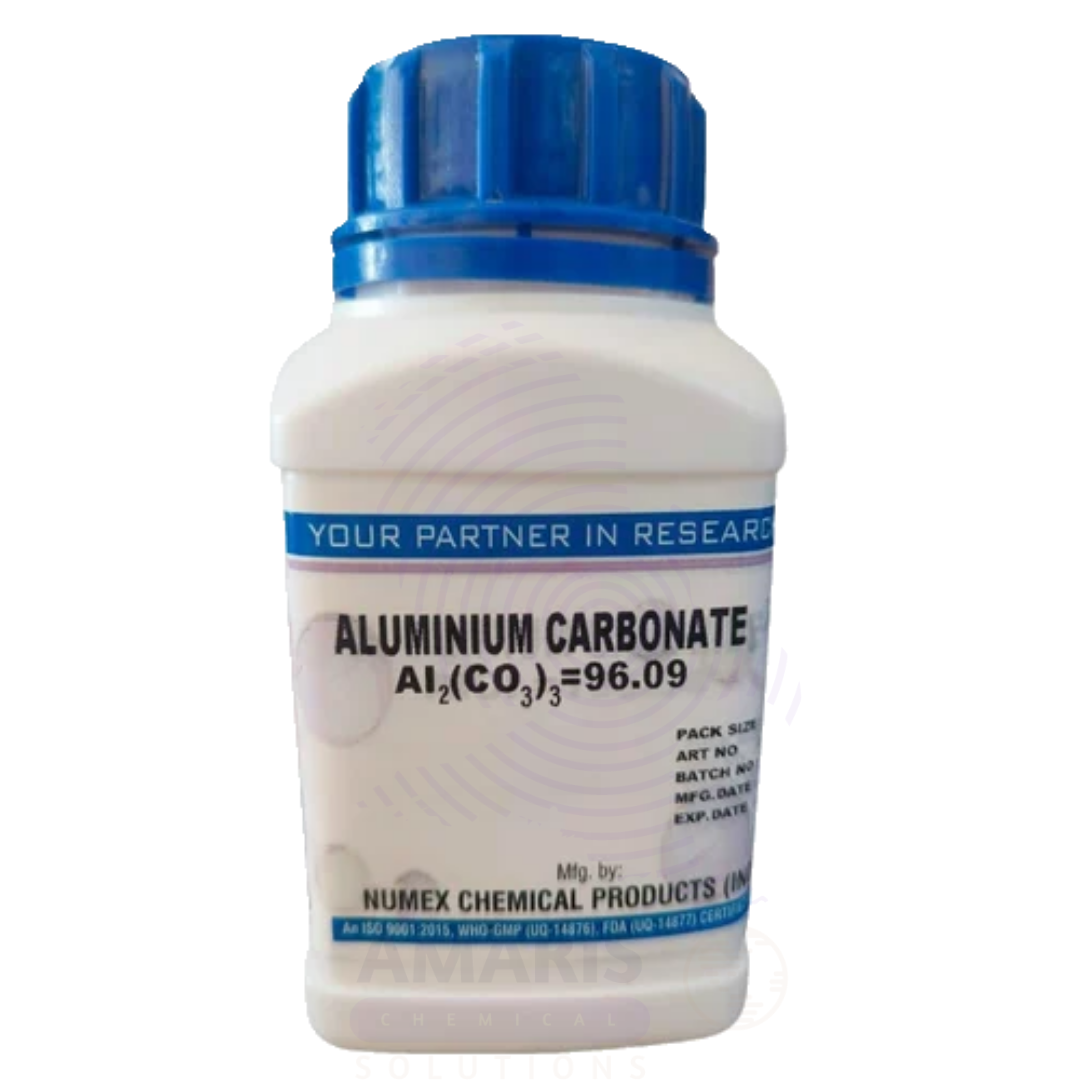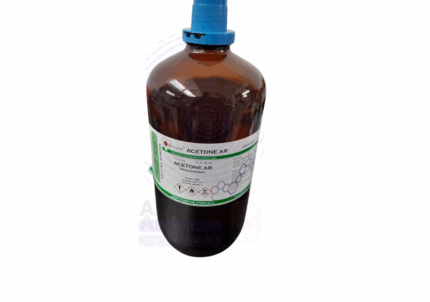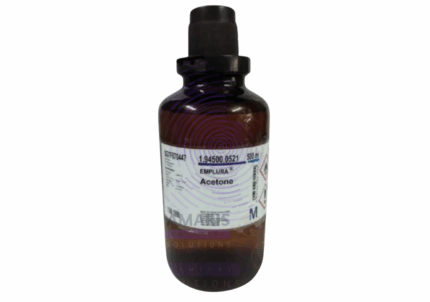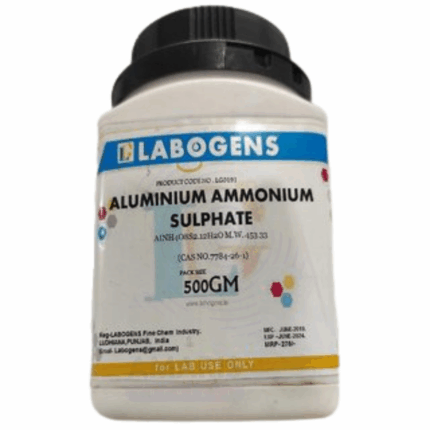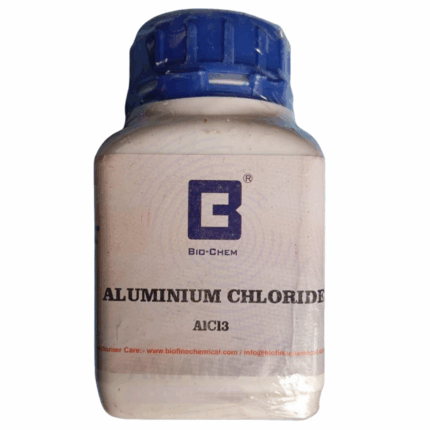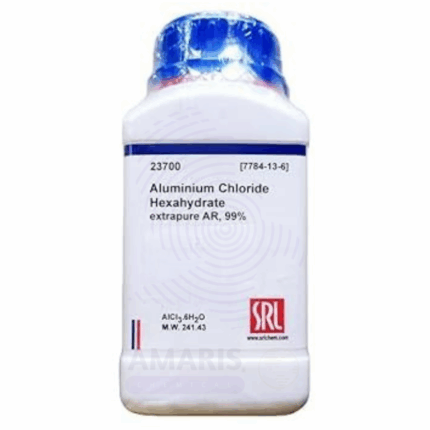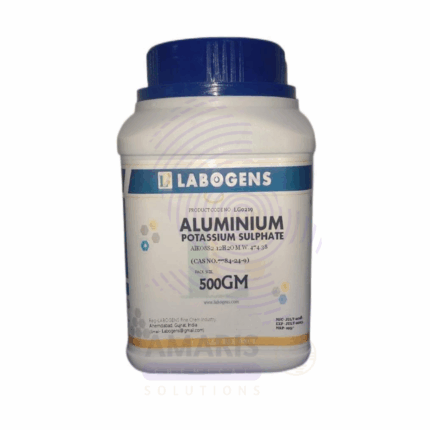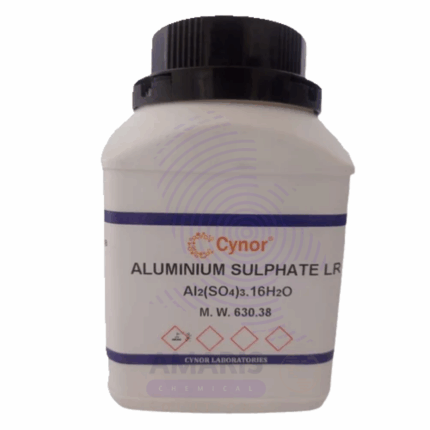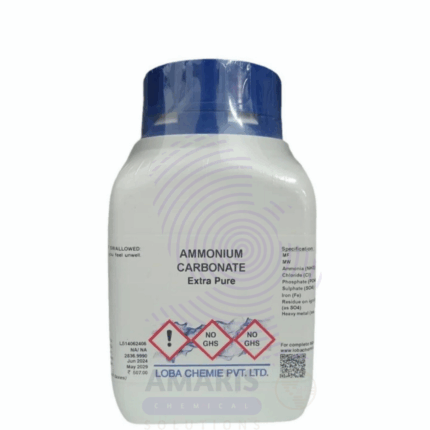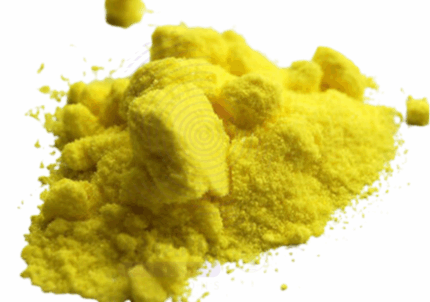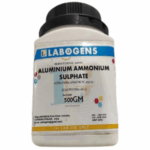
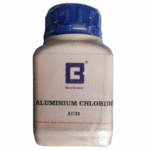
Aluminium Carbonate Extra Pure
$ 18.00 Original price was: $ 18.00.$ 17.89Current price is: $ 17.89.
Aluminium Carbonate Extra Pure is a high-purity, white, odorless powder primarily used as a reagent in laboratory settings for analytical and research applications. Though not commonly stable under standard conditions, it is valued in controlled experimental procedures involving the study of aluminum compounds, buffer systems, and inorganic reactions. Its extra pure grade ensures low levels of contaminants, making it suitable for precise qualitative and quantitative analysis. Due to its sensitivity to moisture and tendency to decompose into aluminum hydroxide and carbon dioxide, it must be handled with care and stored in airtight containers under dry conditions to maintain chemical integrity during laboratory use.
Aluminium Carbonate Extra Pure
Primary Uses
- Analytical Chemistry Reagent
- Used in qualitative analysis involving precipitation reactions and demonstration of carbonate or aluminum ion behavior.
- Preparation of Other Aluminium Compounds
- Serves as a precursor or intermediate in lab synthesis of various aluminum salts (e.g., alum, aluminum hydroxide).
- Buffering & pH-Control Studies
- Applied in experiments that explore weak base behavior and buffer systems involving carbonates.
- Educational Demonstrations
- Used in controlled experiments showing decomposition of carbonates with heat or acid, releasing CO₂ gas.
- Simulated Geological or Environmental Experiments
- Used in soil chemistry studies or laboratory simulations of carbonate mineral reactions.
Secondary Uses
- Study of Thermal Decomposition
- Decomposes upon heating to form aluminum oxide and carbon dioxide—useful in thermal stability experiments.
- Reactivity Investigations in Inorganic Chemistry
- Involved in metal ion exchange, precipitation, and acid-base interaction studies.
- Formulation Testing in Material Science
- Evaluated as a filler or reactive component in prototype materials or ceramics.
- Lab-Scale Neutralization Reactions
- Used to neutralize dilute acids in experimental setups with gentle release of CO₂.
- Ion Exchange or Precipitation Study Models
- Helps visualize solubility equilibria and metal carbonate behavior in aqueous systems.
| PACK SIZE |
250 grams Plastic Tin |
|---|
1. Basic Identification Attributes
- Chemical Name: Aluminium Carbonate (IUPAC: Aluminium(III) carbonate)
- CAS Number: Not officially assigned — the compound is generally unstable and not commercially available in pure form under this name
- HS Code: 28369900 (Other carbonates, excluding sodium, potassium, strontium, barium)
- Molecular Formula: Al₂(CO₃)₃
Synonyms:
- Aluminum carbonate (non-standard name)
- Aluminium(III) carbonate
- Basic aluminum carbonate (in some hydrated forms)
- Hydrated aluminum carbonate (often used interchangeably)
2. Physical & Chemical Properties
- Physical State: Solid (powder, if isolated)
- Color & Odor: White to off-white powder; odorless
- Boiling Point: Not applicable (decomposes before boiling)
- Melting Point: Decomposes with release of CO₂
- Density/Specific Gravity: ~2.1–2.5 g/cm³ (estimated)
- Solubility:
- Water: Decomposes, forming aluminum hydroxide and carbon dioxide
- Organic Solvents: Insoluble
- pH Level: Alkaline upon decomposition
- Vapor Pressure & Volatility: Non-volatile
- Flash Point: Not flammable
- Autoignition Temperature: Not applicable
- Viscosity: Not applicable (solid)
3. Safety & Hazard Attributes
Hazard Class (GHS):
- Not classified as hazardous
- Can cause mild irritation to eyes and respiratory tract if inhaled as dust
NFPA Ratings:
- Health: 1
- Flammability: 0
- Reactivity: 1
- Exposure Limits:
- No established OSHA or ACGIH limits for Al₂(CO₃)₃ specifically
Reactivity:
- Unstable in aqueous solution
- Reacts with acids to release carbon dioxide
- Hydrolyzes in water to aluminum hydroxide
4. Storage & Handling Attributes
- Store in a tightly sealed container
- Keep in a cool, dry, well-ventilated chemical storage cabinet
Incompatible Materials:
- Acids (releases CO₂)
- Moisture (hydrolyzes readily)
Container Type:
- Amber or HDPE containers with moisture barrier
Shelf Life & Expiration Date:
- Relatively short shelf life due to instability in humid conditions (1–2 years if dry)
Special Handling Requirements:
- Minimize dust generation
- Use gloves, goggles, and dust mask in powder-handling areas
5. Regulatory & Compliance Attributes
Regulatory Status:
- Not a listed hazardous substance
- Used occasionally in academic and research settings for theoretical or demonstration purposes
Hazard Symbols (GHS Pictograms):
- None required
- Transportation Restrictions:
- Not regulated for transport
Waste Disposal Method:
- Dispose of as non-hazardous inorganic chemical waste
- Neutralize if necessary and follow institutional disposal protocol
6. Environmental & Health Impact
Ecotoxicity:
- Low aquatic toxicity; decomposes to non-toxic aluminum hydroxide
Persistence in Environment:
- Not persistent due to hydrolysis
- Carcinogenicity/Mutagenicity:
- Not classified as carcinogenic or mutagenic
Biodegradability:
- Inorganic compound — not biodegradable but environmentally neutral upon breakdown
SAFETY PRECAUTIONS
- Personal Protective Equipment (PPE):
- Wear laboratory gloves (e.g., nitrile), safety goggles, and a lab coat.
- Use a dust mask or fume hood if powder becomes airborne.
- Handling:
- Avoid generating dust and prevent contact with eyes and skin.
- Handle inside a well-ventilated area or fume hood.
- Use standard lab tools (e.g., spatulas, weighing boats) to minimize exposure.
- Storage:
- Store in a tightly closed container in a cool, dry, and well-ventilated lab cabinet.
- Protect from moisture, acids, and incompatible materials such as strong acids (reacts to release CO₂).
- Hygiene Measures:
- Wash hands thoroughly after handling and before leaving the lab.
- Do not eat, drink, or apply cosmetics in the lab.
FIRST AID MEASURES
- Inhalation:
- Move the person to fresh air immediately.
- If breathing is difficult, provide oxygen and seek medical help.
- Rinse mouth and nose with water if irritation occurs.
- Skin Contact:
- Wash thoroughly with soap and water.
- Remove any contaminated clothing.
- Seek medical advice if redness or irritation persists.
- Eye Contact:
- Flush eyes gently with water for at least 15 minutes.
- Keep eyelids open during rinsing.
- Get medical attention if discomfort or vision issues persist.
- Ingestion:
- Rinse mouth with water.
- Do not induce vomiting.
- Seek medical attention immediately, especially if symptoms occur.
- Generally low toxicity, but lab-grade material should always be treated cautiously.
FIRE FIGHTING MEASURES
- Suitable Extinguishing Media:
- Use water spray, dry chemical powder, CO₂, or foam depending on surrounding materials.
- Specific Hazards:
- Aluminium carbonate is not flammable, but may release CO₂ gas when reacting with acids or at high temperatures.
- Decomposition can generate aluminum oxides and other irritants.
- Protective Equipment for Firefighters:
- Wear self-contained breathing apparatus (SCBA) and full protective gear.
- Firefighting Instructions:
- Isolate fire area and remove any compatible lab chemicals.
- Use extinguishing media appropriate for nearby flammable substances.
- Avoid inhaling fumes from decomposed material.
Related products
Acetone Extra Pure
Aluminium Ammonium Sulphate Extra Pure
Aluminium Chloride Anhydrous Extra Pure
Aluminium Chloride Hydrated Extra Pure
Aluminium Potassium Sulphate Hydrated Extra Pure
Aluminium Sulphate Anhydrous Extra Pure
Ammonium Carbonate Extra Pure
Ammonium Carbonate Extra Pure is a high-quality, white crystalline solid widely used across various scientific, industrial, and food-related applications. Manufactured to stringent purity standards, this compound is ideal for laboratories and processes that demand high-grade reagents. With its characteristic ammonia-like odor and ability to decompose upon heating, ammonium carbonate plays a versatile role in both chemical reactions and physical processes.
In aqueous solution, ammonium carbonate breaks down into ammonium bicarbonate and ammonium carbamate, further releasing ammonia (NH₃) and carbon dioxide (CO₂) upon heating. This property makes it especially useful in applications that require controlled gas release or temporary pH modification.


 Preservatives(food)
Preservatives(food) Flavor Enhancers
Flavor Enhancers Acidulants
Acidulants Sweeteners
Sweeteners Antioxidants
Antioxidants Colorants(food)
Colorants(food) Nutraceutical Ingredients (food)
Nutraceutical Ingredients (food) Nutrient Supplements
Nutrient Supplements Emulsifiers
Emulsifiers
 Collectors
Collectors Dust Suppressants
Dust Suppressants Explosives and Blasting Agents
Explosives and Blasting Agents Flocculants and Coagulants
Flocculants and Coagulants Frothers
Frothers Leaching Agents
Leaching Agents pH Modifiers
pH Modifiers Precious Metal Extraction Agents
Precious Metal Extraction Agents
 Antioxidants(plastic)
Antioxidants(plastic) Colorants (Pigments, Dyes)
Colorants (Pigments, Dyes) Fillers and Reinforcements
Fillers and Reinforcements Flame Retardants
Flame Retardants Monomers
Monomers Plasticizers
Plasticizers Polymerization Initiators
Polymerization Initiators Stabilizers (UV, Heat)
Stabilizers (UV, Heat)
 Antifoaming Agents
Antifoaming Agents Chelating Agents
Chelating Agents Coagulants and Flocculants
Coagulants and Flocculants Corrosion Inhibitors
Corrosion Inhibitors Disinfectants and Biocides
Disinfectants and Biocides Oxidizing Agents
Oxidizing Agents pH Adjusters
pH Adjusters Scale Inhibitors( water)
Scale Inhibitors( water)
 Antioxidants(cosmetic)
Antioxidants(cosmetic) Emollients
Emollients Fragrances and Essential Oils
Fragrances and Essential Oils Humectants
Humectants Preservatives
Preservatives Surfactants(cosmetic)
Surfactants(cosmetic) Thickeners
Thickeners UV Filters
UV Filters
 Fertilizers
Fertilizers Soil Conditioners
Soil Conditioners Plant Growth Regulators
Plant Growth Regulators Animal Feed Additives
Animal Feed Additives Biostimulants
Biostimulants Pesticides (Herbicides, Insecticides, Fungicides)
Pesticides (Herbicides, Insecticides, Fungicides)
 Active Pharmaceutical Ingredients (APIs)
Active Pharmaceutical Ingredients (APIs) Excipients
Excipients Solvents(pharmaceutical)
Solvents(pharmaceutical) Antibiotics
Antibiotics Antiseptics and Disinfectants
Antiseptics and Disinfectants Vaccine Adjuvants
Vaccine Adjuvants Nutraceutical Ingredients (pharmaceutical)
Nutraceutical Ingredients (pharmaceutical) Analgesics & Antipyretics
Analgesics & Antipyretics
 Analytical Reagents
Analytical Reagents Solvents(lab)
Solvents(lab) Chromatography Chemicals
Chromatography Chemicals Spectroscopy Reagents
Spectroscopy Reagents microbiology-and-cell-culture-reagents
microbiology-and-cell-culture-reagents Molecular Biology Reagents
Molecular Biology Reagents Biochemical Reagents
Biochemical Reagents Inorganic and Organic Standards
Inorganic and Organic Standards Laboratory Safety Chemicals
Laboratory Safety Chemicals Specialty Laboratory Chemicals(Special Laboratory Equipment)
Specialty Laboratory Chemicals(Special Laboratory Equipment)
 Demulsifiers
Demulsifiers Hydraulic Fracturing Fluids
Hydraulic Fracturing Fluids Scale Inhibitors(oil)
Scale Inhibitors(oil) Surfactants(oil)
Surfactants(oil) Drilling Fluids
Drilling Fluids
 Dyes and Pigments
Dyes and Pigments Bleaching Agents
Bleaching Agents Softening Agents
Softening Agents Finishing Agents
Finishing Agents Antistatic Agents
Antistatic Agents
 Admixtures
Admixtures Waterproofing Agents
Waterproofing Agents Sealants and Adhesives
Sealants and Adhesives Curing Compounds
Curing Compounds Concrete Repair Chemicals
Concrete Repair Chemicals Anti-Corrosion Coatings
Anti-Corrosion Coatings
 Surfactants(cleaning)
Surfactants(cleaning) Builders
Builders Enzymes
Enzymes Solvents (Cleaning)
Solvents (Cleaning) Fragrances
Fragrances
 Electronic Chemicals
Electronic Chemicals Catalysts
Catalysts Lubricants
Lubricants Photographic Chemicals
Photographic Chemicals Refrigerants
Refrigerants Automotive chemicals
Automotive chemicals Pyrotechnic Chemicals
Pyrotechnic Chemicals
 Biodegradable Surfactants
Biodegradable Surfactants Bio-based Solvents
Bio-based Solvents Renewable Polymers
Renewable Polymers Carbon Capture Chemicals
Carbon Capture Chemicals Wastewater Treatment Chemicals
Wastewater Treatment Chemicals
 Pigments
Pigments Solvents(paint)
Solvents(paint) Specialty Coatings
Specialty Coatings Binders/Resins
Binders/Resins Additives
Additives Driers
Driers Anti-Corrosion Agents
Anti-Corrosion Agents Functional Coatings
Functional Coatings Application-Specific Coatings
Application-Specific Coatings
 Fresh Herbs
Fresh Herbs Ground Spices
Ground Spices Whole Spices
Whole Spices Spice Blends
Spice Blends Dried Herbs
Dried Herbs
 Leavening Agents
Leavening Agents Dough Conditioners
Dough Conditioners Flour Treatments
Flour Treatments Fat Replacers
Fat Replacers Decoratives
Decoratives Preservatives(baking)
Preservatives(baking)
 Plasticizers & Softeners
Plasticizers & Softeners Reinforcing Agents
Reinforcing Agents Adhesion Promoters
Adhesion Promoters Vulcanizing Agents
Vulcanizing Agents Antidegradants
Antidegradants Blowing Agents
Blowing Agents Fillers & Extenders
Fillers & Extenders Accelerators & Retarders
Accelerators & Retarders